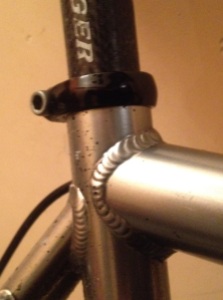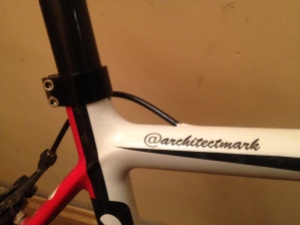A brief bicycle history, materials and architecture
The first two-wheeled, self propelled machine that looked vaguely like a bicycle was invented in 1817 by Baron von Drais. Constructed entirely in wood it was effectively a “walking machine that would help him get around the royal gardens faster”. Both wheels were the same size, with the front steerable and the Draisienne or hobby horse as it was known propelled by straddling and pushing your feet along the ground.
The first ‘pedalled‘ bicycle didn’t appear until 1865 where the pedals were directly fixed to the front wheel. Again, this “bicycle” was entirely made from wood with in later years the tyres made from metal; an uncomfortable ride which earned it’s popular nickname ‘boneshaker’.
With the advances in metallurgy the first ‘all-metal’ bicycle made an appearance in 1870; known in the US as ‘The High Wheel Bicycle’, its common name this side of the pond was The Penny Farthing bicycle.
It was the next jump in metallurgic skills just 100 years ago that brought us the next innovation with a bicycle where the metal was strong enough to make a fine chain and sprocket.
If you’re interested in bike history then click HERE for the Pedaling History Bicycle Museum in Orchard Park, NY.
This short history lesson is basically to conclude that the original bicycles were made of wood but due to advances in metallurgy they then became metal constructions.
From the late 19th century until the 1970s the favoured form of bicycle frame construction was in a lugged steel; the main sections of the frame were constructed with standard cylindrical steel tubes and are then connected with lugs (steel external fittings) which fit over the ends of the tubing. Constructed in this way with a lower-temperature silver brazing at the lugs, there was less chance of weakening the steel alloys compared to high-temperature welding.
With further advances in steel production the thicknesses of a steel double-butted frame (on a currently manufactured Reynolds 953 tube) can create a frame tubing steel tensile strength in excess of 2000 MPa with the thickness of the tubes down to an incredible 0.3 mm).
What this means is that steel frame has a perfect combination of incredible strength with beauty; with the thinness and small diameter of the tubing combining to create elegance and power. Compare the following sequence of photographs showing the difference in tubing sizes in different materials at a similar location:

The delicate diameter tubes and elegant brazed lugwork of a hand built British frame (Ken Bird), excuse the chips, it’s literally been around the block a few times

Oh dear, the traditional frame builders would be turning in their graves at this aluminium frame detail

A beautifully detailed carbon fibre frame (Dolan Bikes) but the tubes are still nowhere near the diameter of steel.
So where did it go wrong for steel? The problem is that even with decreasing thicknesses of tubes, steel is a heavy material and it was never going to compete weightwise with the new kid on the block – carbon fibre.
All well and good I hear you say but what is the connection between bike materials and architecture? With every advance in materials science there is a connection between building and bicycle construction. We wouldn’t have seen the metal bicycle without the first wrought iron bridges. And what’s interesting is that although costly at the moment, carbon-fibre is forecast also to be used in the construction industry.

In “Design Futures” the author Bradley Quinn discusses the use of carbon fiber (as well as other advanced materials) as a possible material that can provide more resistance to natural disasters that older housing technologies simply can’t.
“Carbon fiber is incredibly strong and very flexible. The thinking behind carbon fiber architecture is that it can withstand earthquakes. It would be more flexible in the wind than regular structures,”.
So back to the title of the post “What goes around comes around”… We started this with the first bicycle that was entirely made of wood and in today’s sustainable, ecological future where timber frame construction is the benchmark in passive design and airtightness, we are finishing the post with a bicycle again made of wood. A wooden bicycle like no other that has competed against some of the best carbon fibre bikes in the world and beaten them (Kona qualifier Tim Winestorfer of Vancouver, Washington rode the prototype Hoodoo from RenovoBikes in the World Triathlon Championship in Kona, Hawaii, October 9th, 2010.
Lets finish with the same seat tube detail on the beautifully polished hardwood frame from Renovobikes.com:
Photographs of bikes (except Renovobikes are from Marks small yet increasing bike collection.

Great post! On a sad note, the bicycle museum in Orchard Park you linked to has closed (I only know this because I grew up near it and my mom was living down the road from it until recently). I believe the owner passed away and nobody wanted to take it over and now the collection is being sold off piecemeal- what a tragedy.
I’ve seen those Renovo bikes at their showroom near San Francisco and they are spectacular.
Hi Mark
Aw, that’s a shame.
What’s interesting is that we’re meant to be low-carbon architects yet the first material I’d get a bike in would be Carbon-fibre. Guess it’s in such small quantities? Is it ecological?
Mark
ps I might also do a blog post on other wooden bikes; there are a few now